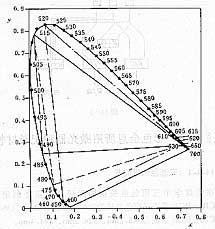Holograms for recording three-dimensional objects in general using holographic plates can be used with He-Ne lasers. For shooting large depth of field objects, a long coherence length He-Ne laser can be used. When using dichromate gelatin as a recording medium, an Ar+ laser with an output wavelength of 400 nm is preferably used. For a photoresist, a He-Cd laser with an output wavelength of 441 nm or an Ar+ laser with an output wavelength of 457.9 nm should be selected. . If you are shooting a hologram of a moving object, you need a pulsed laser.
Although the colors of objects in nature are varied and varied, according to the visual theory of color, there are three kinds of cones that are sensitive to the red, green, and blue (R, G, B) colors. We call these three colors primary colors. Studies have shown that the various colors in the natural world can in principle be mixed with different proportions of the three primary colors. This different proportion is reflected in the photographic material, and it is a different gray scale. Color offset printing is the conversion of different grayscale recording media into a printing plate made up of dots of varying sizes and uneven density, and then overprinted with four primary colors or multicolors to reproduce the manuscript's level and tone. Although the color holographic printing has a very different way from the color printing in reproducing the original color, the former uses the yellow, magenta, cyan, and black inks to reproduce the original by color subtracting, while the latter uses the red, green, and blue primary colors. An additive color method reproduces the color of the original, but the principle of decomposing the original in the three primary colors and reproducing the color of the original in the three primary colors is the same except that they differ greatly in the specific process technology in the copying process. Therefore, a white laser should be used when recording a true color hologram of an object. Studies have shown that the three primary colors can correspond to three pure spectra. For this reason, the International Commission on Illumination has developed three primary colors. The 1931 CIE-RGB true three-primary color system specifies that the wavelength of the red primary color = 700.0 nm, the wavelength of the green primary color = 546.1 nm, and the wavelength of the blue primary color = 435.8 nm. The 1964 CIERGB system provides that the primary colors of red, green, and blue are 645.2nm, 526.3nm, and 444.4nm. Hologram recording requires the use of lasers. The output wavelength of existing lasers is generally inconsistent with the wavelengths of the three primary colors. Therefore, it is only possible to use relatively close wavelengths. For example, a K+ white laser or an Ar+-Cd laser can be used as a three-primary laser source. According to the current status of the laser industry, the laser output suitable for holographic plate making has the following sets of wavelengths for selection (as shown in Table 2).
Table 2 Trichromatic laser wavelengths for color holography
Group wavelength/nm laser color group wavelength/nm laser color 1 647.1
520.8
476.2
氪氪氪
RGB
5 632.8
514.5
477.1
Helium-helium argon argon
RGB
2 647.1
520.8
441.6
Cadmium-cadmium
RGB
6 647.1
514.5
488.0
Argon-helium-argon-helium-argon-helium
RGB
3 632.8
514.5
488.0
Helium-helium argon argon
RGB
7 636.0
635.5
533.7
537.8
441.6
Cadmium-cadmium
Cadmium-cadmium
Cadmium-cadmium
red
green
blue
4 632.8
532.0
488.0
æ°¦-æ°–
Nd:YAG
Argon
Red and green yellowish blue
The principle of selection is mainly based on the sense of reality of color, and the area of ​​the triangles occupied by the three wavelengths in the xy chromaticity diagram (Fig. 2) should be maximized, taking into account other factors such as the output power of the laser. For example, in Table 2, the third group (solid triangles in Figure 2), the second group (dotted triangles), and the fifth group (dotted triangles in Figure 2), the second group dominates from the chromaticity diagram, and yellow More abundant; and from the output power point of view, because the 477.1nm wavelength power is much smaller than the 488.0nm power, the third group is more appropriate. In addition, the appropriate three-primary laser wavelengths should be selected according to the conditions of the laboratory.
When recording with a three-primary laser, three holograms are overlaid on a dry plate. If the hologram is still illuminated in the direction of the reference light with a three-primary laser, there are nine diffracted light waves that make up the original image. The three diffracted light waves of the holograms formed by the three wavelengths of red, green, and blue for the respective colors are in the same direction, and a true color virtual image with the same color as the object is generated. However, they generate diffracted light waves with different directions in six directions for holograms formed by light waves of different colors, resulting in color crosstalk of reproduced images. Therefore, one of the keys to true color holography is the elimination of color crosstalk.
Figure 5-7 1932CIE chromaticity diagram

Source: Graphic Arts Perspective
The size of the fabric Sleeper is small which takes less space and easy to move. You can have a fabric sleeper at your office which is more comfortable for lunch break. And you can use it as a sofa at office time. The fabric sleeper sofa is also easy to intall. There are different types of fabric sleeper, you can choose the fabric sleeper suitable for you.
Fabric Sleeper,Chaise Lounge Sofa Chair,Fabric Chaise Lounge Sofa,Fabric Chaise Lounge Chair
Kaifeng Lanwei Smart Home Co., Ltd , https://www.sofas-world.com
![<?echo $_SERVER['SERVER_NAME'];?>](/template/twentyseventeen/skin/images/header.jpg)